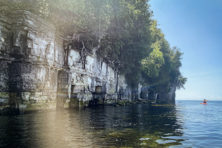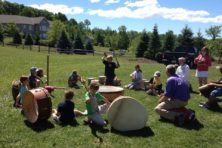Kayaking Algoma Celebrates the Wild Side of the Ahnapee
- Share
- Tweet
- Pin
- Share

One of the fastest growing sports in North America is taking off in Algoma, too.
Whether you enjoy the solitude on a leisurely paddle or prefer a good conversation and hearty workout with others, kayaking has something for everyone.
You can float, photograph and fish the Ahnapee River, experience the clear water and forested shorelines of Krohn’s or West Alaska lakes, or paddle the shallows of Lake Michigan itself on calm days.
Fresh air and exercise, no motor noise and the thrill of being so close to the water are among the many draws of kayaking.
The Ahnapee River and area inland lakes are perfect for nature lovers. Bring binoculars or a camera and enjoy the wild surroundings, or try tangling with bass, pike or panfish.
Some adventurous kayakers get dropped off at Forestville Dam County Park and paddle more than eight miles of water to Algoma, landing on the sand at Crescent Beach. Depending on the current (faster in spring or after a major rain event), type of kayak and whether you push it or take breaks to enjoy the scenery, expect the trip to take anywhere from two to four hours.
Many visitors take advantage of a modern float-style kayak, canoe and stand-up paddleboard launch at Olson Park, along Highway 42. You won’t even have to get your feet wet as you push off or pull on at the new launch.
For those looking to give it a try before buying their own, canoes and kayaks are available at the Ahnapee River Trails Campground and Timber Trail Campground, both just north of Algoma on the west shores of the Ahnapee. And new for 2019, Explore Algoma offers kayak and paddleboard rentals from a shack at the city’s Olson Park.
According to the National Sporting Goods Association, kayak participation grew from 5.9 million in 2007 (the first year the group began tracking participation) to 9.6 million in 2016 (the latest year estimates are available).
The growing interest in personal watercraft may be, in part, due to a huge selection of relatively inexpensive kayaks flooding the market these days.
For a minimal investment, you can be exploring or fishing a wide variety of waters. But buyer beware — some of the cheapest kayaks are also the least stable. Expect to pay $300-$500 or more for kayaks with better stability, storage and other amenities.
The American Sportfishing Association notes that about 10 percent of freshwater anglers fished from kayaks in 2016, more than double the 2011 numbers. While kayaks outfitted especially for fishing typically go for $1,000-$2,000, you can fish out of a cheaper model as well.
Kayaking 101
Today’s kayaks are lighter and easier to carry, maneuver and transport. The seats are getting more comfortable, too.
Before you start enjoying your new kayak — or climb into a rental — familiarize yourself with it on shore, or in very shallow water.
Taking lessons, visiting a pro shop, renting or learning from an experienced kayaker are all good ways to get started.
First, you’ll need to figure out what type of kayak will suit your lifestyle and choice of waters to explore best. Sit-in and sit-on-top kayaks are the most common, but there are many others, including recreational, touring, fishing, inflatable, whitewater and pedal-powered.
Since you typically get what you pay for, it’s important to talk to experienced kayakers before making a purchase, or at minimum checking the stability of a bought or borrowed kayak in very shallow water.
A paddle is as essential as the kayak itself. There are online sizing charts available, but it’s still a good idea to talk to an experienced kayaker for tips. You’ll also need a quality personal flotation device that is both comfortable and has a snug fit, and a waterproof float bag is a great investment to protect your phone and other valuables.
Kayaking can be as challenging or as relaxing as you desire. Done over longer routes, it can provide a very good workout, increasing your cardiovascular fitness and strengthening your arms, core and upper body muscles.
A safe, fun time on the water is what you’re after. The use of sunscreen, polarized sunglasses and appropriate clothing are recommended. It’s always a good idea to paddle with another person, stay sober and keep an eye on the weather forecast.
Both Krohn’s and West Alaska lakes are no-motor waters, so you’ll find the least wake there. East Alaska Lake has a small-horsepower restriction, and the Ahnapee is usually motor-free from Forestville to Blahnik Heritage Park. If paddling elsewhere, be sure you’re visible to those in motorized watercraft.
Charter boats are most active in the river and harbor areas pre-dawn and then mid-morning, when they return. Afternoon trips often leave around noon. Expect the least traffic from charters in the mid-afternoon to early evening hours, or from sunrise to 9 a.m.
You can bring your kayak on Lake Michigan itself, but it’s wise to choose days with very light winds and no storms expected. If you paddle immediately north or south of the piers in shallower water, you’ll be out of the motorboat traffic as well.
There are many other tips available on blogs and websites online, and a short video, dozens of still photos and a commentary of one man’s Forestville to Algoma paddle.
Kayaking can be a very quiet, back-to-nature experience, or you can make it a social gathering with family and friends. Whatever your choice, do it safely and respect the rights of other water users.




